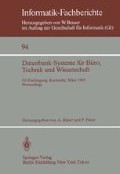Abstract
Advantages claimed for the relational model in the classical data processing domain include ease of use, data independence, increased productivity, and multi-file correlation. These advantages also hold for design applications. However, engineering applications impose several additional requirements.
Access this chapter
Tax calculation will be finalised at checkout
Purchases are for personal use only
Preview
Unable to display preview. Download preview PDF.
References
Chamberlin, D. D., et. al., “SEQUEL 2: A Unified Approach to Data Definition, Manipulation, and Control,” IBM J. Res. Dev. 20, 6 (November 1976), pp. 560–575.
Gray, J., “The Transaction Concept: Virtues and Limitations,” Proc. 7th Intl. Conf. on Very Large Data Bases ( ACM ), September 1981, pp. 144–154.
Hallmark, G., and Lorie, R., “Towards VLSI Design Systems Using Relational Databases,” Proc. Spring Compcon 84 (IEEE), February 1984.
Haskin, R., and Lorie, R., “On Extending the Functions of a Relational Database System,” Proc. Intl. Conf. on Management of Data ( ACM ), June 1982, pp. 207–212.
Hollaar, L., Nelson, B., Carter, T., and Lorie, R., “Structure and Operation of a Relational Database System in a Cell-Oriented Integrated Circuit Design System,” Proc. ACM IEEE 21st Design Automation Conference, June 1984, pp. 117–125.
Katz, R., and Weiss, S., “Transaction Management for Design Databases,”, Working Paper, Computer Sciences Dept., Univ. of Wisconsin, Madison, Wisconsin, 1983.
Lorie, R., and Plouffe, W., “Complex Objects and Their Use in Design Transactions,” Proc. Annual Meeting–Database Week: Engineering Design Applications (IEEE), May 1983, pp. 115–121.
Selinger, P. G., et al., “Access Path Selection in a Relational Database System,” Proc. Intl. Conf. on Management of Data ( ACM ), May 1979, pp. 23–34.
Author information
Authors and Affiliations
Editor information
Editors and Affiliations
Rights and permissions
Copyright information
© 1985 Springer-Verlag Berlin Heidelberg
About this paper
Cite this paper
Lorie, R., McNabb, D., Plouffe, W., Dittrich, K. (1985). A Database System for Engineering Design. In: Blaser, A., Pistor, P. (eds) Datenbank-Systeme für Büro, Technik und Wissenschaft. Informatik-Fachberichte, vol 94. Springer, Berlin, Heidelberg. https://doi.org/10.1007/978-3-642-70284-6_25
Download citation
DOI: https://doi.org/10.1007/978-3-642-70284-6_25
Publisher Name: Springer, Berlin, Heidelberg
Print ISBN: 978-3-540-15196-8
Online ISBN: 978-3-642-70284-6
eBook Packages: Springer Book Archive

